Student Notable
Strategy & Research Award
Core77 Design Awards 2019
DONOR SPACE Bringing everyone together to support the donors involved in BSC donation process
Every 20 minutes, someone is diagnosed with blood cancer or related disorders. For majority of them, in healthcare and medical world the last chance of recovery is stem cell transplant. For the transplant, blood stem cells are often recruited from someone unknown, a volunteer donor. However, one in ten patients does not find a donor.
Today, more than 50,000 transplants are carried out annually. To make that a success, globally stem cells are daily circulated across countries and are increasing every year. In order to meet the continual requirement of stem cells, there is a need for more volunteers.
The donors, a non-patient group invite themselves into medical process of donation. For them, the donation journey isn't an easy process. First of all, becoming a potential match to a patient happens in rare cases. In comparison to other donation procedures, this process is quite challenging and complicated; donor goes through a lot of tedious and time consuming steps over ambiguous time frame. They have lot of individual responsibility, involves considerable commitment and have to connect with a lot of stakeholders involved in the process performing in silos across different geographies. These stakeholders involve NGO, healthcare professionals, family members and in some cases, patients too.
To address these challenges, the project `DONOR SPACE` is developed. It's a framework centred around the donors, focuses on creating a cohesive, end-to-end experience, optimising it for all the stakeholders rather than focusing only on one aspect of the donation process. It revolves around creating awareness, engaging and acknowledging them throughout the process. The service represented is through three key touch points.
Firstly, DONOR FLOCK creates awareness and deeper community engagement around the topic. These information kiosk are strategically placed in public spaces where people can grab a swab kit to register themselves. It supports in making donor registration more convenient and frequent, helping in cutting administration cost.
Secondly, once a donor is potential match to a patient, DONOR DECK; a collaborative platform assists them in navigating the entire process, eliminating ambiguity. It connects them to healthcare professionals, NGO, and pool of donors around the world. It streamline tasks for everyone, reducing burden of travel and overseas cost involved, also providing a support system for their well-being. Finally, when a potential donor becomes exact match to the patient, DONOR PACK including G-CSF injections is delivered to them making them feel appreciated.
The project is developed in collaboration with DKMS Germany, A non-profit advocacy group which works to raise awareness of need for donors, nurses of Haematology department Umeå University hospital as well as patients and donors from around the world. The project is based on user research and analysis, user journey, stakeholder mapping, user testing, value proposition and future testing recommendations. Focus has been Peripheral blood stem cell donation because of its current frequent occurrence than other donation procedures. Visual language is taken into account to make process inviting for the donors.
To communicate the concept, a fictional youtube influencer takes viewers through his donation journey in the video.
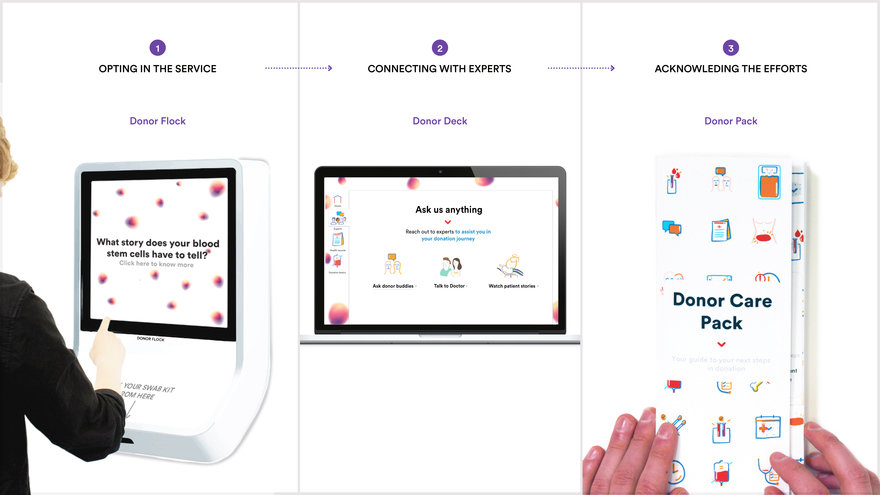 Donor Space touch points
Donor Space touch points
 Blood stem cell donation process overview
Volunteer donor journey (psbc donation)
Blood stem cell donation process overview
Volunteer donor journey (psbc donation)
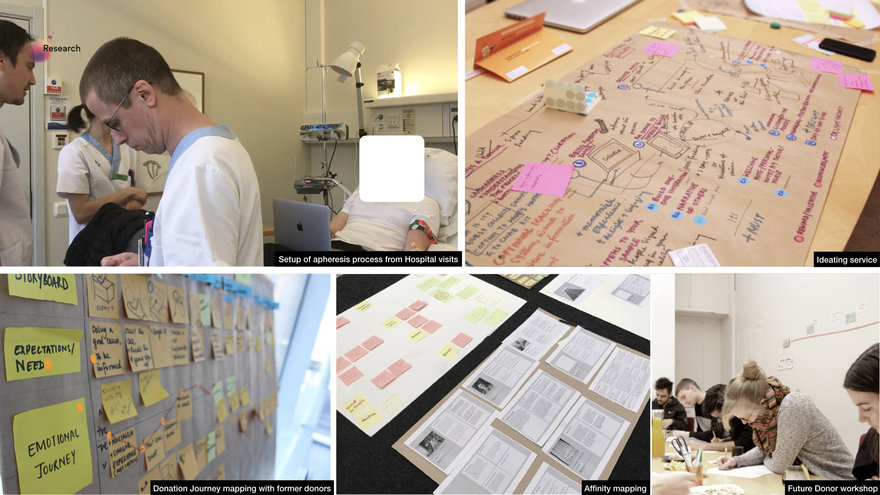 Design Research Phase
Design Research Phase
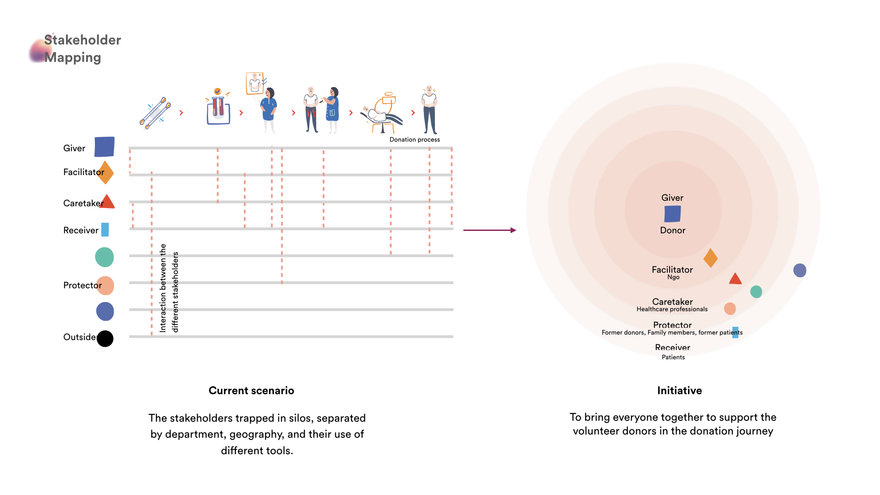 System and stakeholder mapping
Currently segmented process
System and stakeholder mapping
Currently segmented process
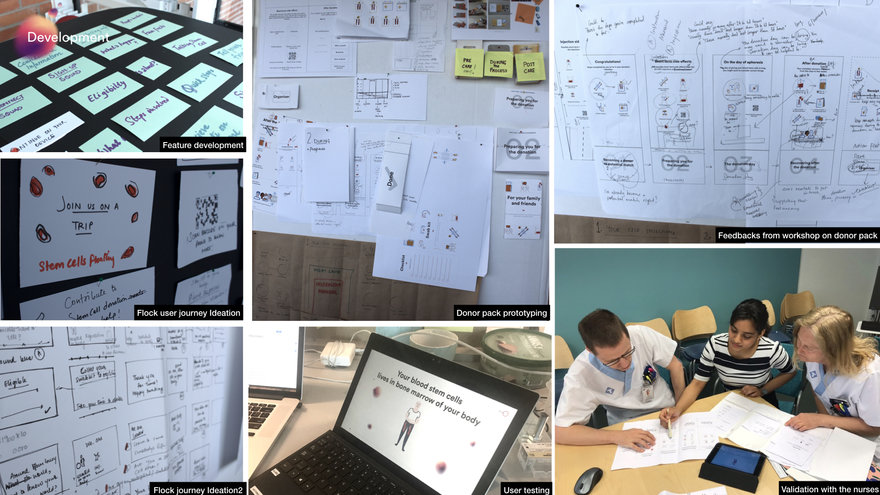 Ideation and concept development phase
Ideation and concept development phase
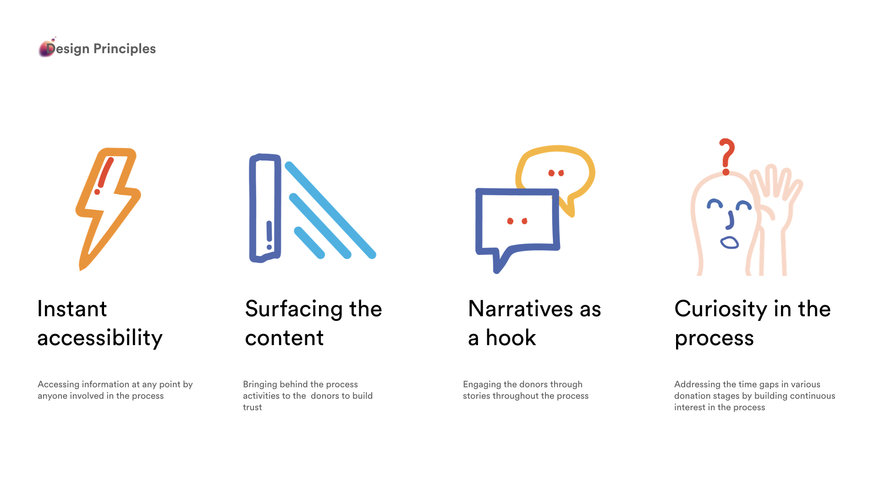 Design principles
pillars for the project
Design principles
pillars for the project
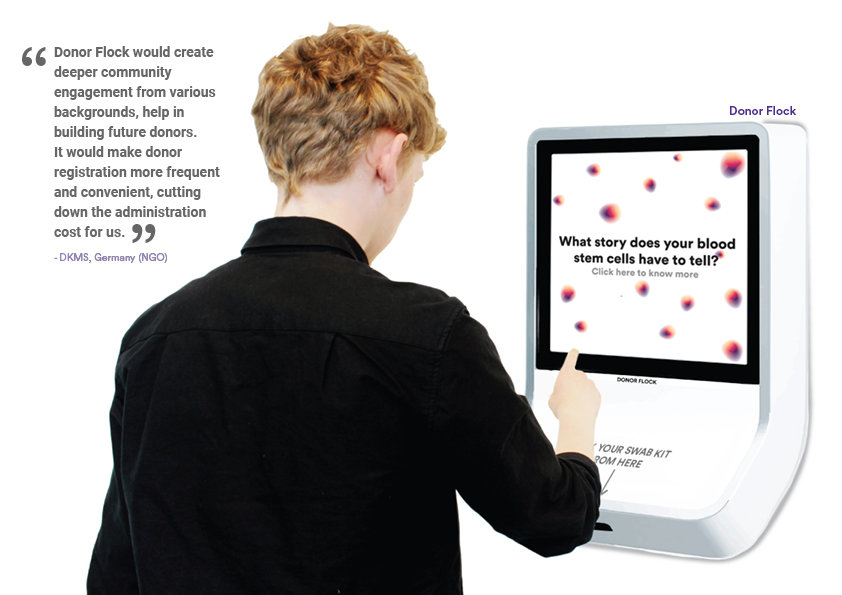 Donor Flock
Donor Flock
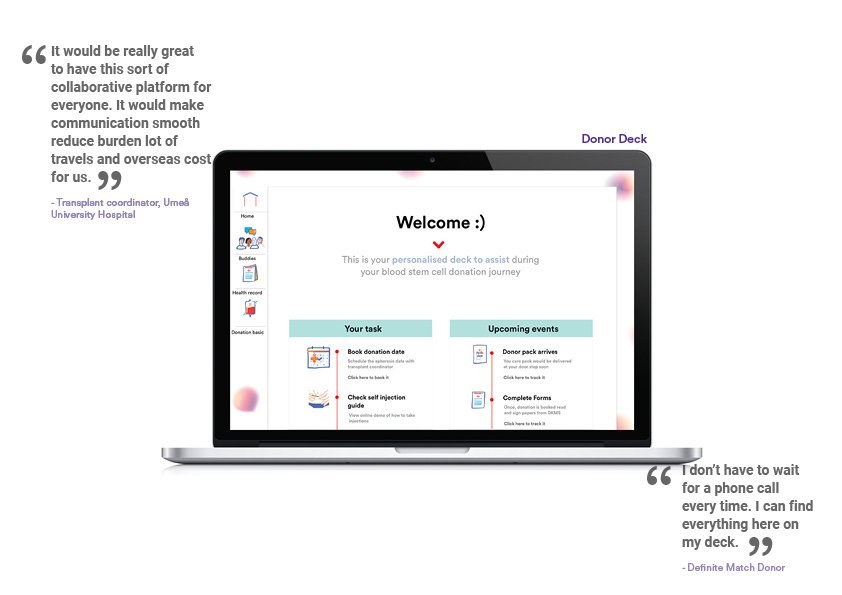 Donor Deck
Donor Deck
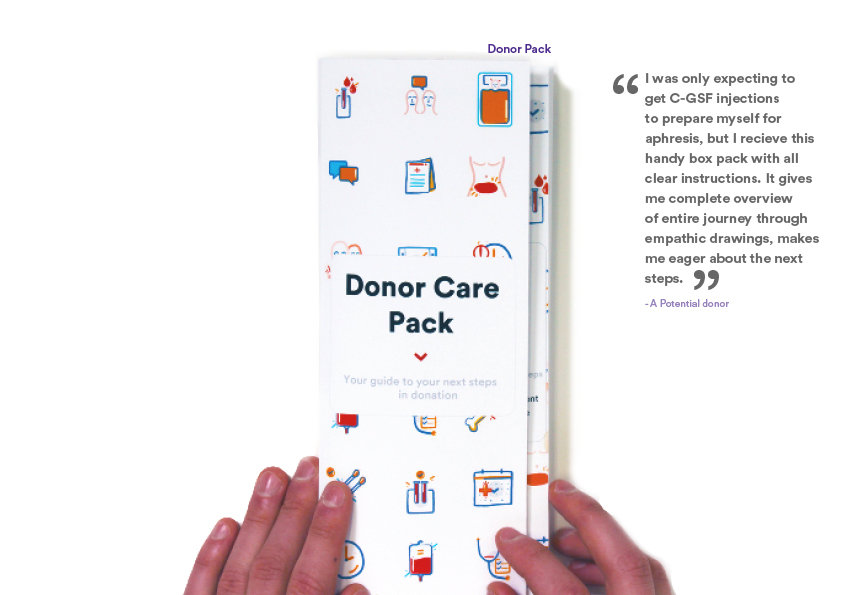 Donor care pack
Donor care pack
 Donor with the care pack
Donor with the care pack
 Donor space service blueprint
Involving all the stakeholders
Donor space service blueprint
Involving all the stakeholders
Background
DONOR SPACE is a result of 20 weeks master thesis project at Umeå Institute of Design, Sweden in collaboration with DKMS, Germany and Hematological Department, Cancer Centre, University Hospital of Umeå. It is funded grants by Kempefonden and Brita-Stina Nordenstedt's Donation.
About the medical process
Blood Stem cell Transplant is a procedure in which a patient receives healthy blood stem cells to replace their stem cells that have been destroyed by disease or by the radiation or high doses of anti-cancer drugs that are given as part of the procedure. The healthy stem cells may come from the blood of the patient or a donor.
Source of Blood stem cells The stem cells may come from the blood or bone marrow of the patient, from a donor, or from the umbilical cord of a newborn baby. Donating stem cells is an act of medical voluntarism, which usually involves no financial cost at the end of the donor.
For the project, narrowed down to allogeneic method (using stem cells donated by someone who is not an identical twin) during the research phase of the project, because of its current frequent occurrence against the other two processes of Autologous (using a patient's stem cells that are collected and saved before treatment) and Syngeneic (using stem cells given by an identical twin).
Collaboration
It is developed with DKMS Germany, a non-profit advocacy group which works to raise awareness of the need for stem cell donors, and haematology department at Umeå University hospital.
Within collaboration, DMKS took in the perspective of the role of validating the project and its relevance at the larger scale to the society. They empowered me explore my ideas and concepts in a designerly way. Interviews, Co-creation workshops and feedback sessions were conducted with them. They gave insights into challenges faced by them in terms of recruiting donors, administering them. Simultaneously, Hematological Department at the hospital addressed their own challenges in regards to the donor, I carried out field visits at the hospital, shadowed nurses, observed apheresis process and co-created with donors and nurses during different phases of the design project.
Vision
Non patient group get underestimated as compared to patient group and healthcare professionals related and limited to hospital environment from an design perspective. I decided to focus and explore aspect of medical volunteerism because they play crucial role in making certain medical processes successful in today's society. The vision is to support donors and stakeholders in the entire process rather than focusing only on one aspect of the donation process. It aims towards enhancing the volunteer donor experience by combining design practices.
Project delivers digital service design intervention that provides practical and applicable design tactics and strategies to develop blood stem cell donor experience.
Methodology and process
Throughout the project, the human-centred approach is applied.
Different stakeholders included donors who have already donated in the past, donor registries, whose intention is to recruit, retain a match donors, healthcare professionals, nurses, transplant coordinators, doctors, family members of the donors and the patients around the world were involved.
I narrowed down to volunteer donor during the research phase because of specific factors:
1. More than 70% of patients won't find a matching donor in their families, so they look for and rely on unrelated donor.
2. Identified motivation of sibling donors is different than a volunteer donor. No matter what they were willing to give, their focus was to save the life of their sibling. During primary research, I reached to sibling donors to understand the similarities and differences.
Considering the Blood Stem cell transplant (HSCT, allogeneic hematopoietic stem cell transplantation ) happens worldwide, different countries have their own rules and regulations around the donation. Health care system in each country has own strategies in assisting the donors and connecting donors patients during and after the donation. Different countries have different setups concerning donor recruitment, management and coordination. Number of quantitative studies have already been carried out by different organisations and countries, the project chose to focus on qualitative studies to obtain new insights.The advantage of using qualitative methods is that I could explore and dig deeper into why? I chose depth interviews why´s and observation as qualitative method tools. I had unparalleled access to all the stakeholders involved in the project. I had the perspective of the nurses and transplant coordinator from Umeå University Hospital, Sweden, DKMS from Germany, former and potential donors, patients, family members from the United States, United Kingdom, India, Germany, Sweden, Finland, Switzerland, Poland, and the Netherlands. I decided not to touch the relationship between the donor and receiver because of ethical issues of how and when donor-patient can contact each other after the donation.
The healthcare system of one country does not bound my project. It is at higher level where any of the healthcare systems could adopt the outcome of the project.
Design Research process
The goal of research was to validate the project direction, to understand better the context –motivations to become a donor, the pain points and challenges of who have donated in the past, and find out opportunity areas. I had access to critical information such as donor names and contacts that I won't disclose. However, this did not affect the process of creating insights/findings, and eventually the deliverables.
To begin to research, social media was used to look for donor to conduct interview. In first five week, academic papers were referred, interviews with different focus groups were conducted, field visits to observe the apheresis process and mapping of the donation journey with former donors were conducted and the last week was synthesis week.
The research phase broadened the initial intent which was earlier to focus only on volunteer donors to rather involve all the stakeholders to then create a holistic experience
Research synthesis
All the collected data was mapped out and key stakeholders were identified.
The stakeholder mapping served as a basis for clustering of findings and having a systematic overview of the process.
Insights were analysed as opportunity risk and Key findings from synthesis included:
A. Lack of Community engagementwithin different social backgrounds and ethnicities about donation. Currently, People registered in the donor registries were mostly working in healthcare and medical field or somehow related to the medical domains, that's how they learnt about the process. Others were through donor drives and campaigns. On the other hand, there is rising concern of lack of blood stem cells for different ethnicities and social backgrounds. Mostly had the misconception of it been a painful process.
B. Segmented process Stakeholders involved in the process trapped in silos, separated by department, geography, and used different tools to communicate with donors and among themselves. Donor wanted to have one point to contact for the donor build the trust and comfort in the donor.
C. Verbal miscommunication When in the process, donors understood the process but indeed didn't understand the complexity involved it. There were specific points in the donation, where they expressed that it was hard for to recall things told by NGO or healthcare professional over telephonic conversations. In some cases, they forgot or got anxious of not knowing things. Most of the crucial decisions were made over phone conversations.
D. Lack of Donor acknowledgementDonor expressed concerns about not been acknowledged after the donation. They felt neglected and un recognised for their efforts at their workplace and among their peers, some disagreement with their family members also. Also, in a lot of cases donor undermined their efforts thinking about what patient was feeling. One of them, felt abandoned after the donation, she was expecting much more.
Opportunity areas were identified in the different phases of the donation process and five underlying principles were developed for concept development.
Concept development
The phase was based on the findings and updated research question in the research synthesis and design principles. There were several iterations of participatory ideation workshops with students at school, donors, their family member and nurses at Umeå Hospital, remote ideation with Donors, patients and DKMS. Between these ideation-rounds, concepts were updated and refined.
During this phase, the donor journey was categorised into on boarding, engaging in the process and off boarding process.
Prototyping and Testing
The resulting concepts were mapped in the form of early sketches and prototypes into a service-framework. The donor journey was developed into animation format and shared with the stakeholders. Based on the feedbacks received final concept was selected to explore further, refined and eventually resulted in the design proposal.
The touch points in the service were picked because of its novelty factor, highlights existing visible artefacts in the service and to the existing service.
Way forward
The project outcome can readily be tested and implemented for the donors to improve their experience. A lot of the aspects are also applicable to a sibling donor. At the same time, learnings can be made in medical volunteerism field. I look forward to opportunities to present and share the project, and the chances for development that would follow with DKMS.
Core77 Design Awards 2019
- Built Environment
- Commercial Equipment
- Consumer Technology
- Crowdfunding
- Design Education Initiative
- Design for Social Impact
- Furniture & Lighting
- Health & Wellness
- Home & Living
- Interaction
- Packaging
- Personal Accessory
- Service Design
- Speculative Design
- Sports & Recreation
- Strategy & Research
- Tools & Work
- Transportation
- Visual Communication